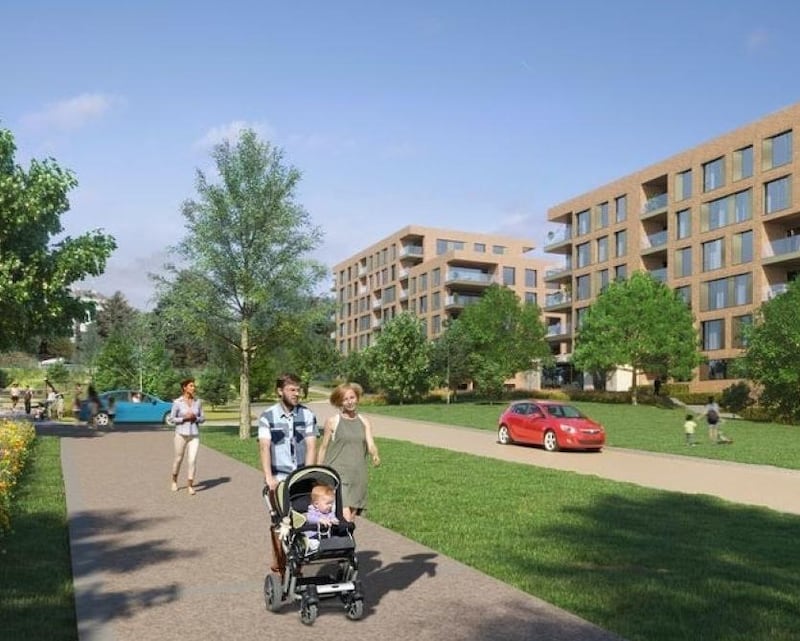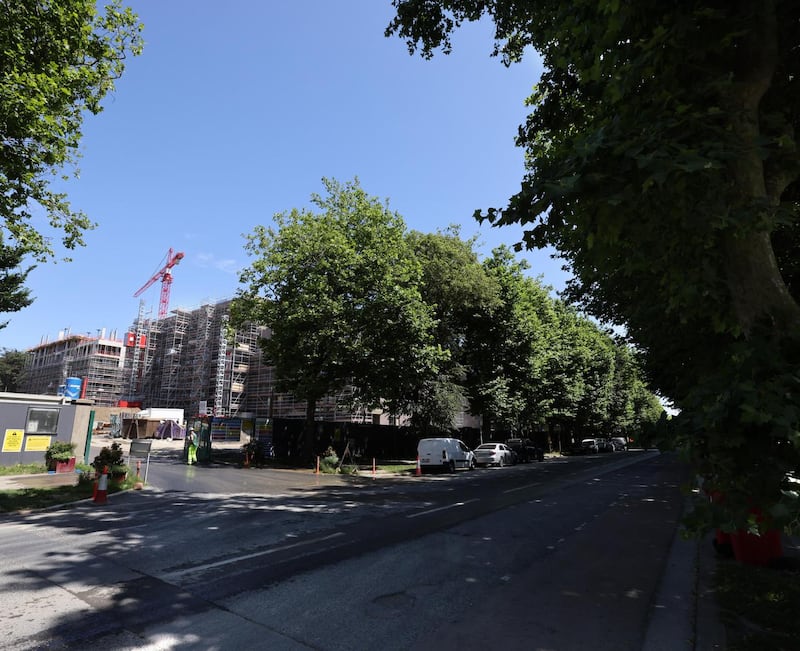What links the Anglo-Irish aristocracy, the Catholic Church and American property funds? They have all, in turn, exercised control over Irish land. And they are all linked to a specific site on the northside of Dublin that tells a story about the current housing crisis.
This is a story about land – who owns it, who profits from it and how, over the centuries, the public interest and the welfare of citizens get shoved aside. It contains in microcosm centuries of a history in which everything changes but nothing changes.
The other day I passed by a huge building site on Griffith Avenue. I stopped to admire it. On what I remembered as an open three- hectare field, seven big handsome apartment blocks are emerging.
This building site embodies, albeit in a contemporary form, the vision conjured over generations by Irish political movements and parties: the security of that thing called home
The site will have 377 apartments and eight houses. It lifts the heart to see it – you can imagine in real life the scene pictured in the computer-generated images produced by the developer, Cairn Homes: a young couple strolling along in front of the blocks, pushing a bonny baby in a buggy.
This is the future to which so many young Irish people aspire. It embodies, albeit in a contemporary form, the vision conjured over generations by Irish political movements and parties: the security of that thing called home.
Arguably, there would not be such a thing as an independent Irish State if the British regime had been able to satisfy that desire for a homeland. It did not create the conditions in which ordinary Irish people could stay in their own country.
It took far too long to give tenant farmers a right to own the fields they worked. These failures ultimately undermined the legitimacy of the political settlement put in place by the Act of Union.
The site on Griffith Avenue is especially resonant because it is directly opposite the entrance to another housing development, which is called Marino. That was the very first large housing estate built by the newly independent Irish State, a marker of its good intentions for ordinary urban dwellers.
In 1924, when the new country was still struggling to emerge from a decade of turmoil and a civil war, the State was able to come up with the money to build these houses and subsidise their purchase by the tenants. Historian Ruth McManus has called it “probably the most successful housing scheme ever undertaken by Dublin Corporation”.
But if Marino tells us what the Irish State could do a century ago, the site across the road, which is called Griffith Wood, tells us what it is doing now.
The contrast is all the more striking because these two sites were originally part of the same property, the demesne of the Ascendancy magnate, Lord Charlemont.
Morally, if not legally, the land that is now Griffith Wood belongs to the people of Dublin – and in particular to the city's less well-off citizens
Charlemont used the land that stretched across much of the northern edge of Dublin, and the profits derived from his tenants, for the display of his admittedly exquisite Italianate taste.
The surviving buildings of his estate, Belvedere House (now part of St Patrick’s College) and the wonderful Casino at Marino, are architectural gems. But he could afford such refined sophistication only because he and his class had monopolised the control of Irish land.
Times changed. The Charlemonts and their world gradually disappeared. But to whom did their power and property pass? In this case, to the Catholic church. The land on which Griffith Wood is now emerging was bought over by the Christian Brothers.
Where did they get the money? The purchase was part of a complex series of internal church transactions. But essentially, it was all funded by a huge donation to Cardinal Paul Cullen by a Dublin woman called Bridget O’Brien.
She gave the money, unquestionably, for public purposes: “The sufficient and comfortable lodging, dieting, clothing, and educating of a certain number of poor and destitute children.”

This shift from aristocratic to ecclesiastical ownership was part of a much larger phenomenon. In 1978, a survey by Dublin Corporation found that 363.4 acres of the city were owned by priests, 443.8 acres were owned by brothers, and 704.6 acres were owned by nuns – a total of 1,511.8 acres in 187 sites. This was 5.4 per cent of the entire area of the city, and a vastly larger proportion of the land open for new development. But as the religious orders have declined, this huge land bank has been sold off piece by piece, with the profits going to the orders themselves. Land that was essentially public and institutional has been privatised.
Even the lands of the once great Dublin diocesan seminary at Clonliffe, beside the archbishop’s palace, now belong for the most part to a Texas-based property group, Hines. Last week, Hines said it will lodge fast-track plans to construct 1,614 apartments there.
This has become a typical trajectory. Land that was meant to be used for the public welfare (as that was understood in the religious and charitable culture of the 19th century) ends up in the control of distant, super-wealthy property funds.
Oddly, there is actually a provision in the Constitution that seems to suggest that this could not happen. Article 44.6 states: “The property of any religious denomination or any educational institution shall not be diverted save for necessary work of public utility and on payment of compensation.” Nobody seems very interested in testing what “public utility” might mean in practice.
During the same period that they sold the Griffith Wood land, the Christian Brothers withdrew an offer to give land worth €127m to the State as partial redress for the children abused in the industrial schools they had run so disastrously
Morally, if not legally, the land that is now Griffith Wood belongs to the people of Dublin – and in particular to the city’s less well-off citizens. But moral claims have no value as chips in the casino of property development.
The Christian Brothers sold the land to Argentum Holdings, a joint venture between an Australian investment fund, Anchorage, and Irish builder Newlyn Construction. In 2016, Cairn Homes paid €100 million for Argentum's six sites, one of which was the Griffith Wood land. Given those sorts of prices, it would be surprising if the brothers did not get something in the region of €10 million for the land.
What’s especially interesting about this is that during this same period, the Christian Brothers withdrew an offer to hand over land worth €127 million to the State as part of their contribution towards redress for children abused in the industrial schools they had run so disastrously.
According to the Comptroller and Auditor General in 2017: “The Christian Brothers have advised the Department [of Education] of their intention to transfer the freehold title of these properties solely to the Edmund Rice Schools Trust”, a private charity established by themselves.

The Griffith Wood land should have been handed over to the State as a small contribution to the €1.5 billion cost of the redress scheme. It could then have been used for a contemporary equivalent of the Marino development across the road. Instead, it was an asset from which tens of millions of euro could be extracted for the order, for developers and for global investors.
But that's not even the end of the story. On July 7th, The Irish Times reported that Cairn Homes is selling almost all of the Griffith Wood development to Greystar, a property corporation based in South Carolina, for €180 million.
In the time of the Ascendancy, “absentee landlord” was a term that summed up the iniquity of the Irish property system. Now, it’s just an unremarkable fact of life.
The price paid by Greystar values the units in Griffith Wood at an average of €523,391. The American corporation obviously expects to extract far more than that in rent from each apartment.
This means that those rents will have to be very high. That couple with the baby in the buggy in the promotional pictures had better have two very high-paying jobs. They cannot be like the people who moved into Marino a century ago: ordinary working-class and lower-middle-class couples getting out of the overcrowded inner city.
History proceeds. Regimes change. But what does not change is a conspicuous absence. At no stage over the 250-year history of this site have the interests of ordinary Irish people come first
History proceeds. Regimes change: aristocracy, church, global corporation. But what does not change is a conspicuous absence. At no stage over the 250-year history of this site have the interests of ordinary Irish people come first. Even when they have direct claims on the land – through Bridget O’Brien’s bequest or the industrial school redress scheme deal – those claims are way down the list of priorities.
We know what the public interest looks like. Cross the road from Griffith Wood, which is now a suburb of South Carolina, and you can see public housing that was well designed, properly planned and funded by a state that was young and poor.
But what use is that? It merely gave ordinary people good lives. All it did was give them the basis for optimism about the future, not just of their own families, but of the fragile new State they now inhabited.
The State struggled to live up to that promise. But it did have some notion that, if it was to hold together at all, it would have to be a place that ordinary people could call home. There is too much money to be made for that naive belief to be sustained.
















